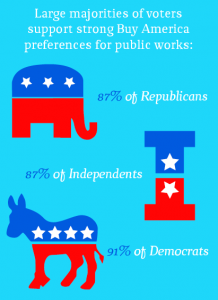Trained in America; Clothed in China
 When ABC reported last week that the $1,400-$1,900+ uniforms Ralph Lauren won the contract to provide to Olympic athletes were made in China, Sherrod Brown not only pushed the US Olympic Committee to try to rectify the issue by the Winter 2014 Olympics, but he introduced a bill to require Federal uniforms to be made in the US (currently, they must be 51% US made).
When ABC reported last week that the $1,400-$1,900+ uniforms Ralph Lauren won the contract to provide to Olympic athletes were made in China, Sherrod Brown not only pushed the US Olympic Committee to try to rectify the issue by the Winter 2014 Olympics, but he introduced a bill to require Federal uniforms to be made in the US (currently, they must be 51% US made).
But the news–which came out just before the Alliance for American Manufacturers released their yearly poll showing near unanimous support for what could be called an industrial policy to support US manufacturing–had a more interesting public relations effect.
For example, after CNN posted a list of US manufactured clothes in response to the uniform news, the sales of Lawson Nickol’s Ohio company, All American Clothing Company, skyrocketed to 14 times what they normally would be.
Brown had a conference call with Nickols (whose company is located outside of Dayton) and Youngstown native Nanette LePore (whose clothes are manufactured in the US, though of foreign–usually Italian–cloth) to talk about efforts to bring back clothing manufacture to the US.
Both make a profit–though not the same margins they’d make if they outsourced to China. LePore noted that Ralph Lauren spends his money on advertising rather than manufacturing. Nickols claimed his jeans last longer, which helps to offset the somewhat four times higher costs. But ultimately they were both sacrificing some profit to keep manufacturing close. For Nickols, it seems like a quality and patriotic issue. It’s patriotic for LePore, too, but manufacturing in midtown Manhattan also gives her much more direct control over her line.
And both mentioned things that would help bring clothing manufacturing back to the US–much of it pertaining to sourcing for lower cost runs.
At this point, we’re largely talking about symbolic gestures: Olympic uniforms, Federal uniforms, jeans made 6 hours away. But the underlying message seems to be (and AAM’s poll backs this up abstractly) that people will seek out things made in the US.

I prefer made in the USA, when I can get it. And I try to buy local, if I can.
A couple years ago, I gave some knitters on my Christmas list some yarn, grown locally, cleaned, spun and dyed locally, and (IIRC) from locally grown natural dyes. Big, big hit.
And I’ll pay a premium – not a big one that says I’m being taken, but a decent one for a local producer.
When I can’t, I’ll buy the generic or store brand. I just can’t see paying a premium for a “name” brand when the difference in price is going to advertising, vulture businessmen, and similar crap.
I think I’m in good company and big company in these positions.
just back from a road trip up to Healdsburg. stretching my legs found a boutique named “made in the usa” featuring American designers. great designs & quality.
we have not yet forgotten how to make quality clothes.
manufacturing them in larger quantities…
p.s. with the amount of roadwork going on the 101 between L.A. & Sonoma, seems there’s still a bit of Stimulus money in the pipeline.
@scribe:
You can get knitting needles made in the US – they’re really pricy, but they’re also top of the line in quality.
@P J Evans: tell it to EW – she’s the one what knits when she ain’t tweetin’
Anyone seen topgrade Egyptian cotton recently? Where I shop, Egyptian cotton has been off the shelf for >10 years.
How about madras block prints? Lots of generic imitations are around, lowgrade cotton, chemical dyes, fairly unispired patterns, no intriguing softening of coloration patterns with aging and laundering… I have not seen the original, vivid madras fabrics in the US for a long time.
I probably need to shop in ethnic business districts for those sorts of items? or simply add it to the metropolitan expedition itineraries. I once found some marvelous India silk in New York City. Figures.
I like international, but quality international. Though I agree with rosalind, however, if only one could afford to shop in that tasteful little city’s central district.
I just buy stuff, I could care less where it was made, I’m no nationalist
I find it difficult to distinguish between discriminating against goods not made in the USA and discriminating against people not made in the USA. I have no problems with either. Those arguments about lowering wages, etc., are used against both allowing goods to come in, and against allowing people to come in.
@John Thacker: Well, it is true that wages for workers drop when they have to compete with outsiders (And I say that as someone married to someone who came here on an H1B–his company employed almost entirely foreign engineers, bc they were cheaper and more docile).
That’s why we have rules to limit how people from other countries come here to work. And as badly as those are abused, they’re still more than we do with goods from other countries.
Just as one example I noted the other day, importers make US pay for the security on shipping those goods to the US, in spite of the fact that unchecked shipping containers is one of the big porous holes in our border and our security. If importers had to pay their own security costs, then there’d be more goods made here.